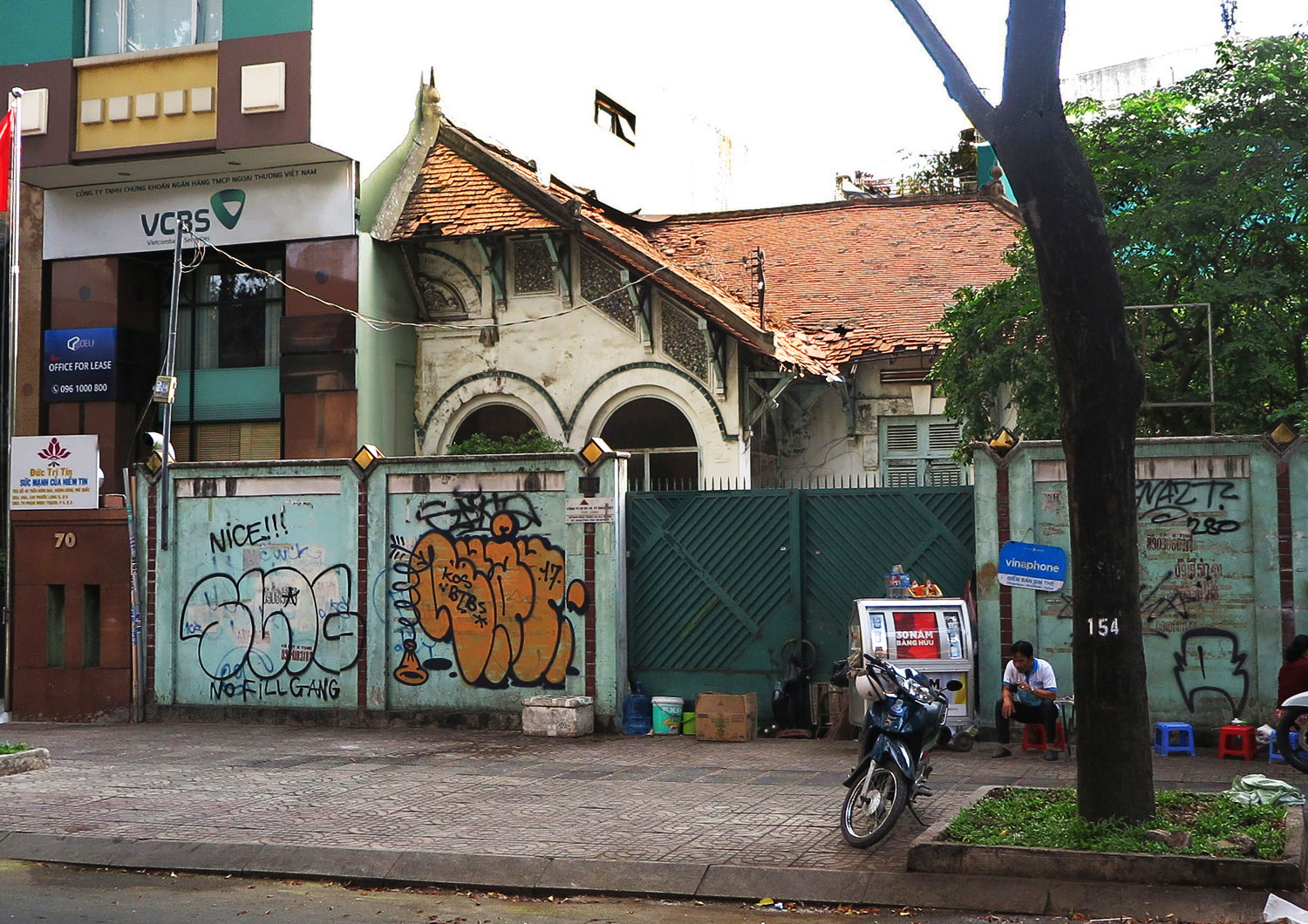
“Half a villa” in its death throes at 51 Phạm Ngọc Thạch
An excerpt from Tim Doling’s latest guidebook, Exploring Saigon-Chợ Lớn: Vanishing Heritage of Hồ Chí Minh City (Nhà Xuất bản thế giới, Hà Nội, 2019), which is on sale now in most major bookshops in Việt Nam.
In recent years, Hồ Chí Minh City has experienced rapid economic growth, which, while improving the lives of many, has impacted heavily on the city’s built heritage. Over the last five years in particular, the destruction of historic structures has reached an alarming rate – hardly a day now passes without some valuable old villa, apartment block or public building being razed to the ground.
A land use master plan for 2025, submitted in 2007 by the Japanese firm Nikken Sekkei Civil Engineering Ltd and approved in March 2008 by the Hồ Chí Minh City People’s Committee, resolved that “the historic core of the city in Districts 1 and 3 should be protected.” However, in recent years, with many high-end development projects east of the river in District 2 taking longer than anticipated to progress, approval has been given for the construction of a spate of new high-rise office, retail and residential projects in the low-rise city centre, leading to the destruction of many existing historic buildings. In many other parts of Asia, the recent boom in high-end property construction has stalled, but at the time of writing, the “emerging market” of Việt Nam, and in particular of Hồ Chí Minh City, is still being touted as a real estate hot spot, posing an ongoing threat to unprotected historic buildings and streetscapes.
Throughout District 1, new reinforced concrete, glass and steel structures designed in the International Style are steadily supplanting many of the iconic buildings which once made Saigon the “Pearl of the Far East.” At a 2014 seminar on urban development, it was also reported that over the previous decade, District 3 had lost a staggering 56% of its French villas.
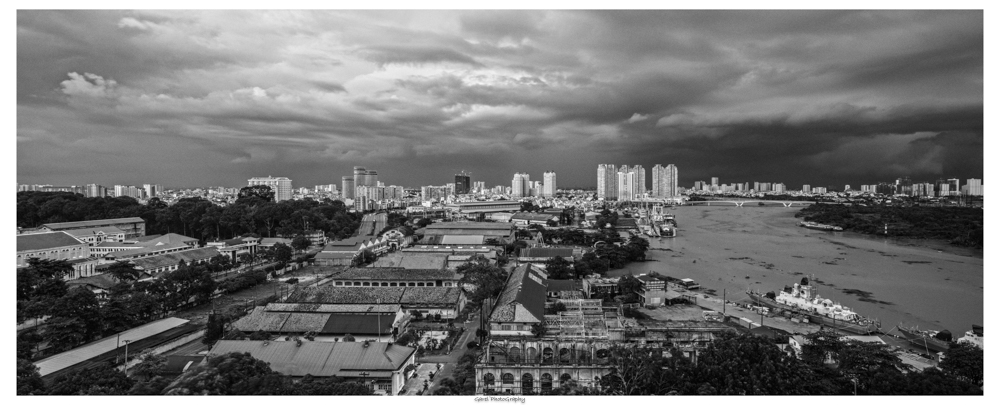
An aerial view of Ba Son Shipyard before its destruction, photograph by Alexandre Garel
Of particular concern to many was the decision to destroy the historic Ba Son Shipyard in order to build luxury apartments. Originally built by Lord Nguyễn Phúc Ánh (Emperor Gia Long) in the 1790s, and only later embellished and developed by the French, Ba Son was undoubtedly Việt Nam’s most important maritime site, with enormous heritage value. In the run-up to the decommissioning of Ba Son in 2015 as part of a plan to relocate ship repair and construction downriver to Cái Mép-Thị Vải, it was recognised that the compound housed many fine examples of French industrial architecture dating back to the 1880s. However, although a single workshop building associated with revolutionary hero Tôn Đức Thắng had been listed in 1993 as a national monument, the complex as whole remained unprotected. Conservationists urged that the whole complex be given heritage status, while tourism experts pointed out how successful other countries (including the USA, Australia and Singapore) had been at transforming old maritime heritage sites like this into heritage, leisure and recreation complexes. However, it was to no avail.
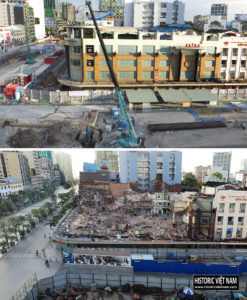
The demolition in 2016 of the Tax Trade Centre, formerly the 1926 Grands Magasins Charner, which involved the loss of a priceless Moroccan mosaic staircase
Continued growth and development is very important to an economic hub like Hồ Chí Minh City, so in addition to its beauty and the key role it plays in reaffirming its citizens’ sense of identity and belonging, heritage must also be credited for its potential economic value. Elsewhere in the world, old buildings are preserved not just for aesthetic reasons, but also for the wide range of economic benefits they can bring. Old buildings shouldn’t be conserved simply as relics of a bygone age, they should be given new uses to help regenerate towns and cities, increase property prices and bring all-round economic development. Effective heritage conservation can help differentiate a city from its competitors, giving it an international brand and helping it attract investment and recruit the brightest and best business talents from all around the world. In short, heritage conservation should not be seen as an alternative to economic development but as a complement to it – preserving and promoting the physical heritage can make sound economic sense.
Realistically, in an environment where property speculation remains rife and developers seek swift returns on their investments, arguments based on longer-term regeneration will continue to have limited impact. However, with tourism becoming an increasingly important cornerstone of the city’s economy, the systematic destruction of built heritage – the very thing which attracts higher-paying and longer-staying cultural tourists – is more likely to elicit official concern.
As yet there seems to be little recognition of the crucial role which built heritage can play in developing tourism, and the potential impact of its systematic destruction on visitor numbers. While the number of tourists visiting Hồ Chí Minh City has continued to increase annually (reaching 6.4 million in 2017, a 22.8% increase over the previous year’s figures), the average visitor stay is just 2.6 days, and more worryingly, according to a 2016 estimate by the Pacific Asia Travel Association, only 6% of first-time visitors ever return.
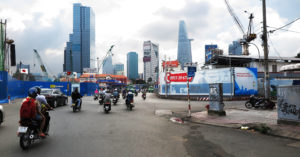
Construction work on Quách Thị Trang square has been ongoing for several years
To date, tourism authorities have responded mainly by increasing the budget for TV advertising or relaxing visa requirements for specific nationalities. Meanwhile, expensive “culture parks” continue to built outside city centres with a view to attracting tourists, with little recognition of the fact that urban heritage with its unique stories is not only woefully underused, but also disappearing rapidly under a wave of unfettered development. The current state of tourism in Saigon is perhaps best summed up in a comment made to the author by the manager of a leading city hotel in 2014: “The problem with Saigon is that there’s nothing for tourists to see.” To this, the author would respond that the expanded content of his latest guidebook suggests quite the opposite – there is in fact a huge amount to see in Saigon – if only the current pace of heritage destruction can be slowed and historic buildings can be restored and presented properly to visitors.
Research elsewhere in the world has shown very clearly that heritage tourism generally attracts older, wealthier people who stay longer, take part in more cultural activities and spend more money, yet little is currently done here to promote this important end of the market. Instead, the very built heritage which attracts such visitors is steadily vanishing.
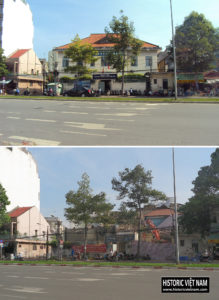
A priceless old French mansion at 66 Hải Thượng Lãn Ông in Chợ Lớn, pictured in 2012 and undergoing demolition in 2017 to make way for a tower block
Many other countries have gone down the same path and have later come to regret it. In Singapore, the Wong Report of 1984 showed that the disappearance of the country’s built heritage had not only removed many of the familiar landscapes which gave its citizens a sense of identity and belonging, but was also one of the principle causes of a decline in tourist numbers. Since then, the government of Singapore has done its best to preserve what’s left, and to develop it sympathetically for both community and touristic purposes.
The current tourist experience in Saigon-Chợ Lớn is limited. This is certainly not the fault of its many excellent and caring tour guides. However, the majority of those tour guides are simply not given the comprehensive grounding in history which is essential to “bring to life” the urban heritage for foreign visitors. This is an area which must be addressed urgently if Việt Nam is to prioritise the development of heritage tourism.
At present, Hồ Chí Minh City is just a one- or two-night stopover for most visitors, who learn very little about its amazing history and heritage. The majority of “city tours” visit only a very small number of attractions – the Post Office (still all too frequently introduced erroneously as a work by Gustave Eiffel), the Cathedral, the Independence Palace, Bến Thành Market, and War Remnants Museum. Little attempt is currently made to promote the city’s many other historic areas.
As in many other cities of Asia, the tourist experience is now also increasingly marred by the deteriorating quality of life in a city beset by traffic chaos and increasingly high levels of air pollution. This situation has been exacerbated in recent years by the construction of massive new apartment and commercial complexes on key arteries, without sufficient attention being paid to upgrading the road infrastructure and parking facilities required to access them.
A core issue contributing to the city’s current absence of protection for its historic buildings is the continued lack of a comprehensive heritage inventory – while the great majority of the city’s old buildings are undocumented, the authorities remain unaware of their history or significance.
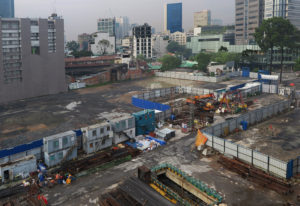
Following the systematic destruction of many old buildings, Saigon city centre has become a wasteland of half-finished construction projects, some of which have no scheduled completion date
It’s obviously unrealistic to expect that all of the city’s old buildings can be preserved, but it’s important that decisions to destroy any building are taken on the basis of accurate information. For example, on 13 June 2011, Tuổi Trẻ newspaper reported that the decision to demolish the 1905 Contrôle financier building at 12 Lê Duẩn to make way for the “Lavenue Crown” complex was made after an architect had incorrectly certified the old building to be a “faux colonial” structure of relatively recent construction. Without a comprehensive inventory and attendant bona fide historical research, planning authorities have no way of ascertain the historic or architectural value of any structure. This means that developers are routinely given the green light to destroy historic structures which should have been afforded protection.
In recent years, the French Hồ Chí Minh City Urban Development Management Support Centre (PADDI) has worked with the People’s Committee to develop an inventory of villas in District 3, but despite this important project, modification and/or destruction of old buildings in that area has continued. Meanwhile, historic structures elsewhere in the city remain completely uninventoried and unprotected.
The procedures defined by the Heritage Law for the protection of historic buildings and streetscapes are also problematic. Remarkably, this historic city of over 10 million people currently has only 170 protected monuments, and these comprise mainly traditional temples, communal houses, pagodas and revolutionary sites. Approval for recognition and protection of around 100 other works – including such iconic buildings as Notre Dame Cathedral, Saigon Post Office, Bến Thành Market, and the Treasury and Customs Directorate buildings – has not yet been given, due to the failure of their owners to submit dossiers to the government. These latter buildings are offered temporary protection on a five-yearly basis, but ultimately, the decision as to whether they are given permanent protection depends on the will of the building owner. Thus most of the city’s historic buildings, including both colonial and post colonial structures, remain unrecognised and therefore unprotected.
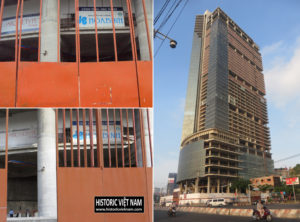
The rusting hulk of the Saigon One Tower, located on a prime riverside site formerly occupied by several heritage buildings, but abandoned in a half-built state since 2011 when construction ceased due to financial problems
In 2014, largely as a response to the proposed demolition of the Saigon Tax Trade Centre, the Facebook group Đài Quan sát Di sản Sài Gòn – Saigon Heritage Observatory was set up by a group of concerned locals to educate the public about the value of heritage, and has since attracted a large membership. More recently in 2016, the Héritage GO mobile app was developed by one of its members to “crowd source” the locations and historic/architectural data about the entire city’s surviving old buildings. These non-official initiatives have been effective in encouraging interest in urban history and in mobilising support for the preservation of heritage buildings, but developers in Việt Nam wield considerable power and influence which invariably outweigh efforts by a handful of dedicated cultural officials and community initiatives to protect the city’s remaining old structures. The need for stronger official action thus remains paramount.
Nowadays, Hồ Chí Minh City is rarely considered as a city of culture or heritage. But this is merely a problem of perception, not of fact. If the current destruction can be halted before it is too late, the city may still have enough heritage buildings left to be considered an important heritage tourism destination. However, several steps will need to be taken as a matter of urgency:
– Identify what’s there by conducting a comprehensive inventory of the city’s historic buildings and carrying out additional research into urban history to highlight the real-life stories behind surviving buildings and streetscapes;
– Widen the scope of the existing Heritage Law to extend legal protection to all buildings and streetscapes of historic and architectural significance, strengthening enforcement and punishment of infringements;
– Impose a strict legal requirement on private developers to conduct heritage impact assessments for all new capital works projects, and introduce powers of compulsory purchase where necessary for a building’s long-term survival and preservation;
– Provide economic incentives for the conservation of privately-owned historic buildings, such as land exchange and transfer of development rights (TDR) schemes, waver of land use fees to compensate owners/developers for their loss of development rights, and in the longer term also perhaps small grants for repairs and regular maintenance;
– Promote the city’s heritage more effectively to visitors, working with local stakeholders to harness the heritage value of buildings and streetscapes as both community and touristic resources, and developing the history curricula of tourism training schools so that tour guides can be trained more thoroughly in the city’s unique living history;
– Develop a heritage master plan with input from both domestic and international experts to ensure that conservation of built heritage becomes an important part of strategic city planning and development.
In this way, the needs of modernisation and urban renewal may be properly balanced with protection of the city’s remaining architectural heritage.
Tim Doling
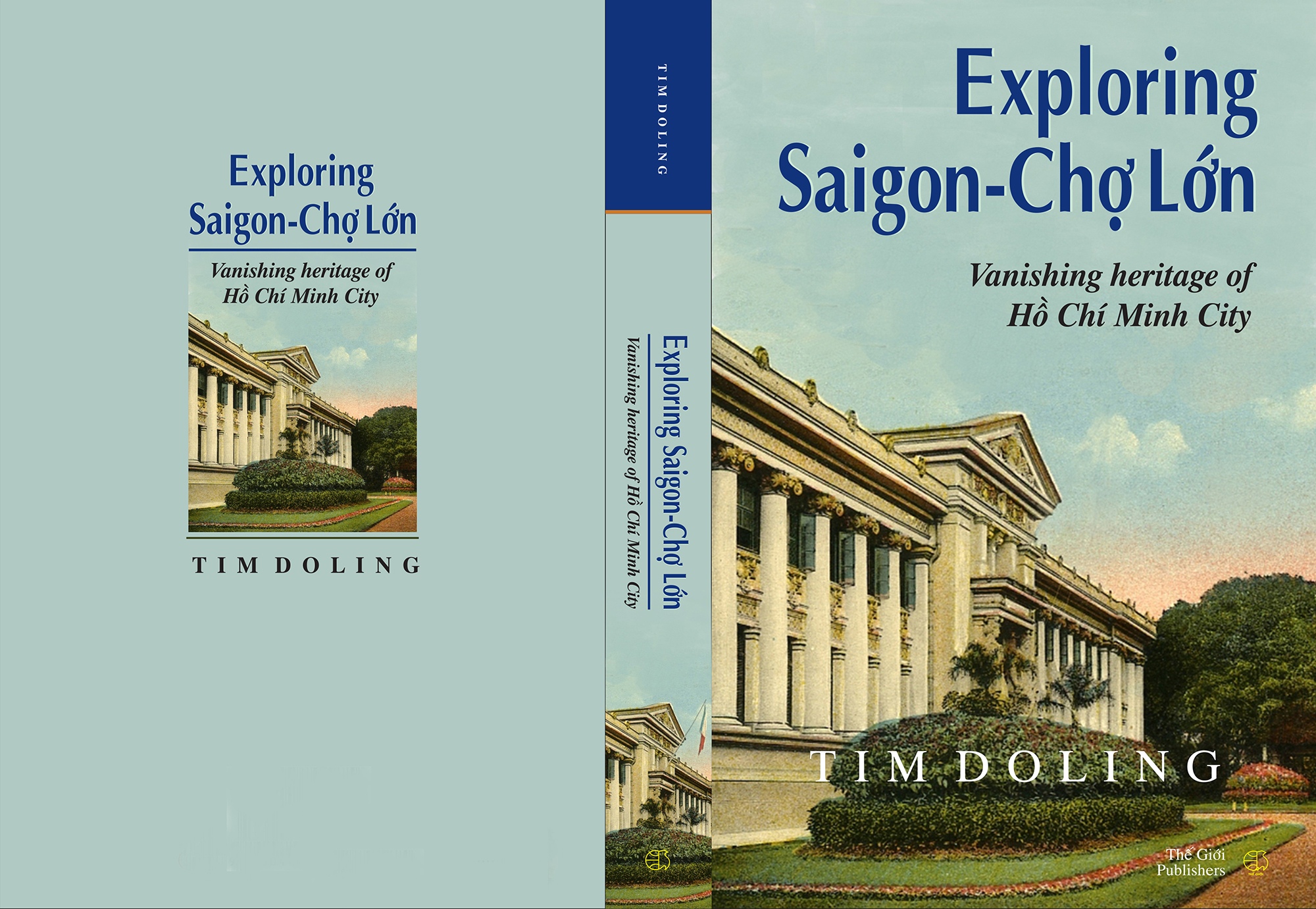
Thế Giới Publishers announces the launch of Tim Doling’s latest guidebook, “Exploring Saigon-Chợ Lớn – Vanishing Heritage of Hồ Chí Minh City.” This is Tim’s second guidebook to the built heritage of the southern metropolis, and takes the form of a much expanded and improved version of his 2014 book “Exploring Hồ Chí Minh City.”









